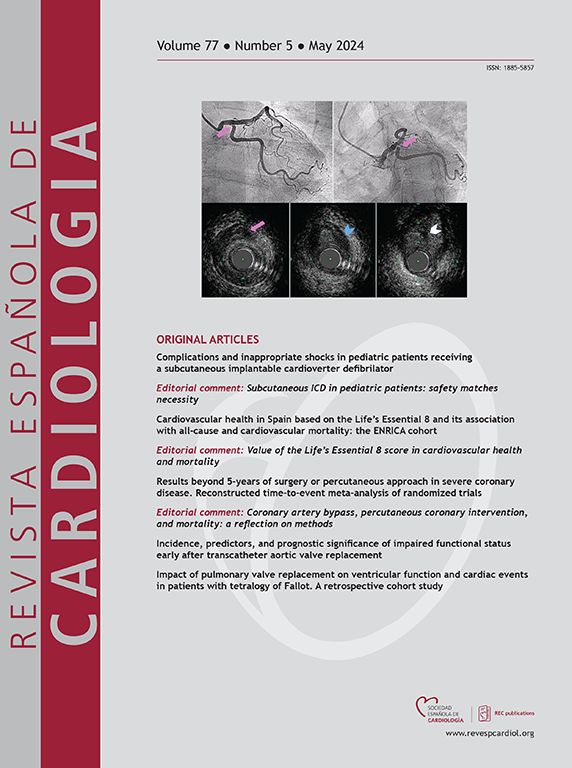青年工人的生活方式与心血管风险:西班牙全境队列研究结果
IF 5.9
2区 医学
Q2 Medicine
引用次数: 0
摘要
这项研究旨在描述西班牙在职青壮年的心血管风险状况及其与生活方式的关系。方法从一家大型职业风险预防公司投保的全国经济活跃成年人队列中招募参与者(18-30 岁),并从常规医疗评估中获取数据。根据参与者是否存在糖尿病前期/糖尿病、高血压前期/高血压或高胆固醇血症,将其归类为心血管风险状况 "不健康 "的人群;如果完全不存在这些情况,则归类为心血管风险状况 "健康 "的人群。结果 共有 78 421 名年轻成年人(27 ± 2 岁,36% 为女性)接受了基线评估。不健康 "的心血管风险状况普遍存在(18%),且与最佳生活方式(体重正常、经常运动、不饮酒/吸烟、睡眠良好)成反比(OR,0.64;95%CI,0.57-0.80)。只有 3.5%的参与者具备后一种条件。另一方面,对 44 776 名参与者进行的前瞻性分析(中位数随访时间=2[2-5]年)显示,有 2.0% 的人从 "健康 "状态转变为 "不健康 "状态。身体活跃(OR,0.95;95%CI,0.81-0.99)和体重正常(OR,0.61;95%CI,0.51-0.70)与这种转变的可能性较低有关。结论 在西班牙从事经济活动的年轻人中,心血管风险因素的发生率很高。不健康的心血管风险状况与最佳生活方式成反比,但后者在这一人群中并不常见。英文全文见:www.revespcardiol.org/en。本文章由计算机程序翻译,如有差异,请以英文原文为准。
Estilo de vida y riesgo cardiovascular de jóvenes trabajadores: hallazgos en una cohorte de toda España
Introduction and objectives
This study aimed to describe the cardiovascular risk profile of working young adults from Spain and its association with lifestyle.
Methods
Participants (18-30 years) were recruited from a nationwide cohort of economically active adults insured by a large occupational risk prevention company, with data obtained from routine medical assessments. The participants were categorized as having an “unhealthy” cardiovascular risk profile based on the presence of prediabetes/diabetes, prehypertension/hypertension, or hypercholesterolemia, or a “healthy” profile if these conditions were completely absent. The association with lifestyle factors (weight, physical activity, sleeping characteristics, alcohol consumption, smoking) was assessed.
Results
A total of 78 421 young adults (27 ± 2 years, 36% female) were evaluated at baseline. The “unhealthy” cardiovascular risk profile was prevalent (18%) and inversely associated (OR, 0.64; 95%CI, 0.57-0.80) with an optimal lifestyle (normal weight, regular physical activity, no drinking/smoking, and good sleep). The latter condition was found in only 3.5% of the participants. On the other hand, prospective analyses in 44 776 participants (median follow-up = 2 [range 2-5] years) showed that 2.0% transitioned from a “healthy” to an “unhealthy” profile. Being physically active (OR, 0.95; 95%CI, 0.81-0.99) and having a normal weight (OR, 0.61; 95%CI, 0.51-0.70) were associated with a lower likelihood of this transition. No consistent associations were found for other lifestyle factors.
Conclusions
The prevalence of cardiovascular risk factors is high in economically active young Spanish adults. An unhealthy cardiovascular risk profile is inversely associated with an optimal lifestyle, but the latter is highly infrequent in this population.
Full English text available from:www.revespcardiol.org/en
求助全文
通过发布文献求助,成功后即可免费获取论文全文。
去求助
来源期刊

Revista espanola de cardiologia
医学-心血管系统
CiteScore
4.20
自引率
13.60%
发文量
257
审稿时长
28 days
期刊介绍:
Revista Española de Cardiología, Revista bilingüe científica internacional, dedicada a las enfermedades cardiovasculares, es la publicación oficial de la Sociedad Española de Cardiología.
 求助内容:
求助内容: 应助结果提醒方式:
应助结果提醒方式:


